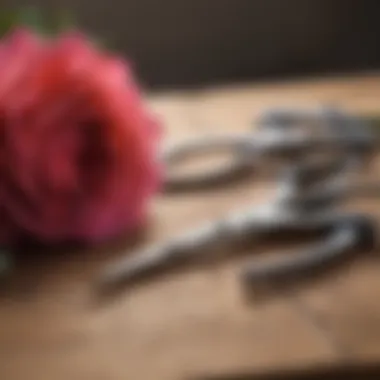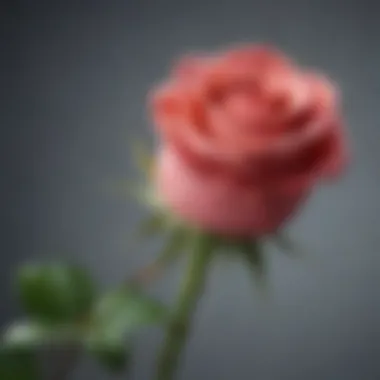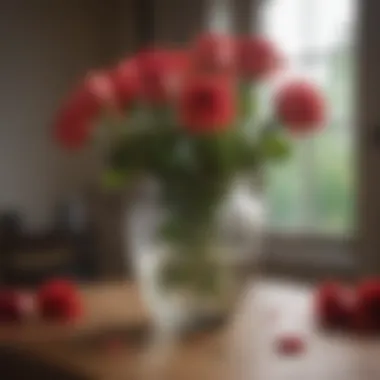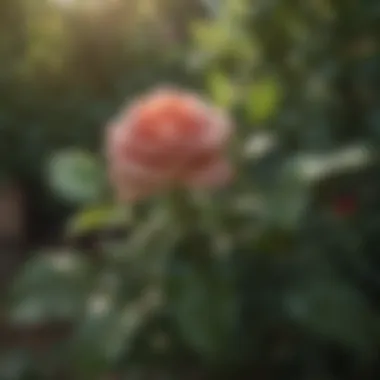Expert Techniques for Cutting Roses for a Vase


Intro
Cutting roses for a vase may seem simple, yet it involves a set of precise techniques and best practices to truly enhance their longevity. Roses can brighten any space, and knowing how to care for them once they are cut is essential for anyone who wishes to enjoy their beauty over time. This guide will walk you through various methods, tools needed, and the optimal conditions for cutting roses.
In this article, you will discover the intricacies of careful cutting, which can significantly impact the health of your roses. This is aimed at both novice flower enthusiasts and those with experience, offering insights that apply to a range of skill levels. Whether you have a home garden full of roses or simply want to arrange a bouquet from a store, understanding the proper techniques is valuable.
The Right Timing
When it comes to cutting roses, the timing is crucial. The best moment to cut roses is early in the morning or late in the afternoon. This is when the temperatures are cooler, and the roses' water content is higher. Choosing to cut at these times ensures that the flowers are well-hydrated, which is essential for their longevity.
Tools Needed
Having the right tools makes the process more efficient and effective. Essential tools include:
- Pruning shears: Sharp and clean shears prevent damage to the stems.
- Cutting gloves: To protect your hands from thorns.
- Bucket: For holding the cut stems upright and hydrated until you arrange them.
Ensure all tools are sterilized before use to avoid introducing pathogens that could shorten the roses' lifespan.
Cutting Techniques
There are various techniques for cutting roses. Here are some key methods to consider:
- Angle cut: Cutting the stem at a 45-degree angle increases the surface area for water uptake, which is vital for keeping the rose hydrated.
- Avoid crushing: Do not crush the stems when cutting. This can hinder water absorption and lead to wilting.
- Cutting length: Aim for varying lengths to create a more visually appealing arrangement.
After Cutting Care
Once you have cut the roses, immediate care is necessary. Place the stems in a bucket of water right away. You can also add preservative solutions to the water, enriching it with sugars and nutrients necessary for the flowers. Keep the bucket in a shaded area temporarily until you are ready to arrange the flowers.
Important: Always re-cut the stems before placing them in the vase to maximize water absorption.
Water and Environment
Once the roses are arranged in a vase, you should monitor their environment carefully. Roses generally thrive in cool, indirect light. Change the water every few days and trim the stems again if necessary to prolong their life. Avoid placing the vase in direct sunlight or near ripening fruit, as this can cause the roses to wilt faster.
Culmination
Cutting roses for a vase is not just a casual task; it is an art that requires understanding and practice. Applying the right techniques can dramatically enhance the lifespan and beauty of your cut roses. This guide should equip you with the knowledge you need to ensure that your flowers remain vibrant and visually pleasing for an extended period.
Understanding Roses
Cutting roses for a vase involves understanding the nuances of these blooms. Knowledge of roses can significantly improve the results for anyone looking to extend the life of cut flowers. Different types of roses have distinct characteristics, which impact their suitability for cutting and display. This foundational knowledge contributes to the overall success of floral arrangements and enhances the aesthetic appeal of any space.
Types of Roses Suitable for Cutting
When selecting roses for cutting, certain varieties shine brighter in terms of longevity and visual appeal. Among the most popular types suitable for cutting are:
- Hybrid Teas: Known for their long stems and large blooms, these roses are a favorite choice for arrangements. They often possess sturdy petals that hold up well.
- Floribunda Roses: These roses produce clusters of small flowers that can create a dense and colorful bouquet. They tend to have plenty of blooms, offering fuller arrangements.
- Garden Roses: With their fragrant scent and beautiful shape, garden roses add elegance to any arrangement. They often feature a more complex bloom structure.
- David Austin Roses: A subsection of garden roses, these are renowned for their unique shape and fragrance, making them highly desirable in floristry.
Selecting the right type involves considering both visual style and resilience after cutting. Evaluating the blooms in their natural state helps gauge their readiness for cutting.


Characteristics of Fresh Cut Roses
Understanding the traits of fresh cut roses is essential for anyone looking to preserve their beauty. Key characteristics to note include:
- Petal Condition: Freshly cut roses should have firm, vibrant petals. Any wilting or discoloration is a sign that the rose may not last long.
- Stem Freshness: The stems should appear moist and green rather than dried or brown. A fresh cut at the base is crucial for enabling water uptake.
- Leaf Integrity: While leaves are essential for photosynthesis, too many leaves can promote bacterial growth in water. They should be healthy but minimal.
- Fragrance: Fresh cut roses maintain their fragrance, which enhances their appeal in any arrangement.
Evaluating these characteristics before cutting maximizes the chances of a successful display in a vase.
Keeping the traits of fresh cut roses in mind is key to ensuring their longevity and vibrant appearance.
Timing for Cutting Roses
Timing plays a critical role in the longevity and quality of cut roses. Proper timing ensures that the blooms are harvested when they are most vibrant and capable of lasting longer after being placed in a vase. The right timing is determined by various factors, including the time of day and the weather conditions at the time of cutting. Understanding these elements can significantly increase the overall aesthetics and lifespan of your roses in a vase.
Best Time of Day to Cut Roses
Cutting roses during specific times of the day influences their water absorption and overall health. The ideal time to harvest roses is during the early morning or late evening hours. This is when temperatures are cooler, and the plants are turgid, meaning they are filled with water. Early morning dew can also help ensure that the roses are hydrated before they are cut. Conversely, cutting roses during the heat of the day can cause unnecessary stress to the flowers, leading to quicker wilting.
Tip: Always aim to cut roses when they feel firm and appear vibrant; this usually translates to a longer vase life.
Weather Conditions and Their Impact
Weather conditions can have a significant impact on the quality of cut roses. Overcast days are typically the best for cutting, as direct sunlight can cause the flowers to heat up and lose moisture rapidly. Additionally, flowers cut during rainy periods often retain more water, contributing to better hydration levels in the vase.
On the contrary, cutting roses during windy or extremely hot conditions could result in stressed blooms and reduced longevity. The key is to monitor local weather patterns and choose days that offer mild temperatures and cloud cover whenever possible. Being mindful of these factors can greatly enhance the quality of the cut flowers.
Essential Tools for Cutting Roses
Selecting the right tools is essential for ensuring that your roses are cut properly, which in turn maximizes their vase life. Good tools help to make smooth cuts, minimizing damage to the plant. This section will cover various types of cutting tools and tips for maintaining their effective use.
Types of Cutting Tools
When it comes to cutting roses, you have several options available. Each tool has its own advantages based on the specific needs of cutting.
- Pruning Shears: Perhaps the most common tool, pruning shears are ideal for making clean cuts. They are sharp and designed to handle stems without causing excessive damage. Opt for bypass shears for a more precise cut.
- Floral Knives: A floral knife is also a common tool. These are especially useful for more delicate operations. The knife allows for a precise and wide cut, which can be beneficial for thicker stems.
- Scissors: Regular scissors can be used in a pinch. However, they may not offer the precision and sharpness required for rose stems, leading to crush damage.
- Loppers: For very thick stems or if you are dealing with rose bushes that have not been pruned recently, loppers are a good option. They can cut through tougher branches effectively.
All these tools have unique features and can provide the user with different benefits. Selecting the right tool is important to achieving that ideal cut without compromising the rose’s freshness.
Maintaining Sharpness and Cleanliness
Once you've chosen your tools, it’s crucial to maintain their condition for optimal performance. Dull or unclean tools can lead to jagged cuts, which makes for an unhappy rose.
- Sharpening: Regularly sharpen blades to ensure a clean cut. Dull blades rip and crush stems, leading to wilting. A whetstone or a sharpening tool can keep your cutting edges in prime condition.
- Cleaning: Before and after cutting, clean the tools with rubbing alcohol or a bleach solution. This helps to eliminate any bacteria, protecting your roses from diseases.
- Storage: Store the tools in a dry location, preferably in a protective case. This will prolong their lifespan and keep them ready for use at any time.
Keeping your tools sharp and clean is vital for the health of your cut roses.
Investing time in maintaining your tools pays off when you see how beautiful your roses can be when properly cut. Good tools lead to good results, ensuring your floral displays are stunning and vibrant.
Cutting Techniques
Cutting techniques are vital for ensuring the longevity of roses once they are in a vase. The way roses are cut influences their ability to absorb water, which is crucial for their freshness and vibrancy. Proper techniques can mean the difference between a bouquet that wilts within days and one that flourishes for weeks. Understanding the elements involved in cutting will empower both novice and experienced flower enthusiasts.


The Correct Angle for Cuts
Cutting roses at the correct angle is essential for maximizing water uptake. When cutting, aim for a diagonal angle of about 45 degrees. This increases the surface area exposed to water and prevents the stem from resting flat on the bottom of the vase, which could obstruct water flow.
- Method: To achieve this, hold the stem firmly and make a clean cut with sharp shears. Avoid sawing motions as they can damage the stem.
- Rationale: A clean cut promotes quicker healing and reduces the risk of disease entering the stem.
Remember: Cut under water if possible to prevent air bubbles from entering the stem, which can impede hydration.
Identifying the Right Stem to Cut
Not all stems are ideal for cutting. When looking at a rose bush, focus on stems that are strong and mature. These tend to have healthy blossoms, indicating they can survive in a vase environment. Consider the following points:
- Choose stems with at least one bud: This ensures that your arrangement will keep blooming.
- Inspect for health: Avoid stems with signs of disease, such as discoloration or brown spots.
By selecting the right stems, you ensure that the cut roses can thrive longer. Healthy roses translate to a more pleasing aesthetic in your vase.
Removing Leaves and Thorns
Once the roses are cut, the next step is to prepare the stems for vase life. Thorns should be carefully removed, as they can create issues when arranging the flowers. Moreover, any leaves below the water line should be stripped away.
- Why Remove Leaves: Leaves submerged in water can decay quickly, which leads to bacterial growth and shortens the vase life of the roses.
- How to Remove Thorns and Leaves: Use a sharp knife or specially designed thorn stripper. Handle stems gently to avoid bruising.
This preparation step plays a significant role in promoting healthier flowers and prolonging their display. Taking the time to achieve clean cuts and proper stem prep enhances the overall enjoyment and longevity of cut roses.
After-Cutting Care
After cutting roses, proper care is crucial to ensure they maintain their beauty and vibrancy. This section focuses on the importance of after-cutting care, which involves hydrating the flowers adequately, selecting the appropriate vase, and ensuring the water is at optimal conditions. These practices directly impact the longevity and quality of the cut roses.
Hydration Strategies for Cut Roses
Proper hydration is fundamental for the vitality of cut roses. Once cut, flowers begin to lose moisture rapidly. Here are some ways to enhance hydration:
- Immediate Watering: Place cut roses in water as soon as possible. This helps to prevent air bubbles from forming in the stems, which can obstruct water uptake.
- Use of Hydration Solutions: Commercial flower food provides nutrients and improves water absorption. These solutions often have a specific balance of sugars, acids, and biocides.
- Re-cut the Stems: Cutting stems again while submerged in water helps increase the surface area for absorption. Use sharp, clean shears to make a fresh diagonal cut.
“The sooner roses are in water after cutting, the better their chances for a longer vase life.”
Choosing the Right Vase
The choice of vase significantly alters how well your roses will fare. Here are key considerations when selecting a vase:
- Size and Depth: Choose a vase that provides sufficient support for the stems while allowing room for leaves and blooms. A taller vase can help support longer stems.
- Material: Clear glass vases are popular, but opaque ones can help keep the stems cooler. Make sure the vase is clean to prevent bacterial growth.
- Shape: Opt for a vase shape that complements the arrangement, allowing blooms to spread naturally and preventing overcrowding.
Optimal Water Temperature and Additives
Water quality and temperature play a significant role in the overall health of cut roses. Optimize conditions with these practices:
- Temperature: Use lukewarm water for the initial fill. This aids in dissolving flower food and is kinder to the stems. Avoid cold water, which can shock the flowers.
- Additives: Along with commercial flower food, you can use simple household items. A small amount of sugar can provide energy, while a few drops of bleach can help eliminate bacteria, ensuring cleaner water.
- Regular Refreshing: Change the water every few days, replacing it with fresh water and re-cutting the stems if necessary. This renews hydration and removes any bacteria build-up.
By implementing these after-cutting care strategies, your roses can thrive much longer, displaying their full potential in your chosen vase.
Common Mistakes to Avoid


Cutting roses for a vase might seem straightforward, yet several common mistakes can undermine your efforts. Recognizing and understanding these errors is essential to prolong the life and beauty of your cut roses. By examining cutting techniques and water care, you can significantly improve the overall health and presentation of your blooms.
Incorrect Cutting Techniques
One of the most critical mistakes when cutting roses is using the wrong angle and method. Proper cutting technique plays a vital role in minimizing damage to the stem and ensuring the flowers receive adequate hydration. The correct angle for cutting is usually at 45 degrees, which helps to maximize the surface area for water absorption. A straight cut can block the stem's ability to take up water, significantly affecting the flower's lifespan.
Another common error is cutting the stems too short. While it might seem practical to keep a bouquet compact, too short stems can hinder their ability to draw water. Always consider the height of your vase and give the stems enough length to facilitate good water access.
In addition, using dull tools can cause jagged cuts that may harm the rose stem. Ensure that your cutting implements are sharp and clean. This not only allows for a cleaner cut but also reduces the risk of introducing bacteria to the open stem. Make it a practice to clean your tools regularly to maintain their effectiveness.
Neglecting Water Quality
The quality of water is often overlooked when caring for cut roses. Using tap water can be problematic due to the presence of chlorine and other chemicals that affect the flowers. Instead, consider using distilled or filtered water to improve the longevity of your roses in the vase.
It's also essential to change the water every few days. Stale water can promote bacterial growth, which can further lead to poor hydration and ultimately quicker degradation of your rose's quality. Adding flower preservative to the water can provide vital nutrients and help manage bacteria, but be sure to follow the instructions carefully—over-dosing can be just as harmful.
A common error in caring for cut roses is sticking with the same water too long, as it increases the potential for bacterial growth.
Keep in mind the vase’s cleanliness as well. Before placing your roses in a vase, wash it thoroughly to remove any residue. This simple step can greatly enhance the longevity of your flowers, providing them a clean environment to flourish.
Environmental Considerations
Understanding the environmental aspects of rose cutting is crucial for not only prolonging the beauty of cut flowers but also for fostering a healthier ecosystem. By considering sustainability and climate impacts, rose enthusiasts can make informed choices that benefit both their floral arrangements and the environment at large.
Sustainability in Rose Cultivation
Sustainable practices in rose cultivation greatly influence the health of the plants and their overall quality. Sustainable rose growing methods reduce the use of harmful chemicals, which can affect not just the plants but also the surrounding soil and water quality. Here are some key points to consider:
- Organic Practices: Utilizing organic fertilizers and pest control helps maintain soil health and decreases environmental toxicity. Roses thrive better when grown in nutrient-rich, chemical-free environments.
- Water Conservation: Employing drip irrigation or rainwater harvesting can significantly reduce water waste. This method allows for direct watering of roses, minimizing runoff and evaporation losses.
- Biodiversity: Encouraging a variety of plants in gardens fosters a balanced ecosystem. Different species can attract beneficial insects and pollinators, which contribute to healthier rose growth and less reliance on chemical treatments.
Choosing sustainably sourced roses can also make a significant impact. When purchasing roses, prefer those from local growers who utilize eco-friendly practices.
Impact of Climate on Rose Quality
Climate plays a pivotal role in the growth and quality of roses. Variations in temperature, humidity, and rainfall patterns can greatly affect their vitality. Here are some aspects to consider:
- Temperature Fluctuations: Extreme temperatures can stress roses, leading to poor growth or increased susceptibility to disease. Optimal temperatures ensure that roses bloom beautifully and last longer when cut.
- Humidity Levels: High humidity can create a conducive environment for fungal diseases. Proper humidity management during cultivation can help maintain clear visibility of rose blooms and reduce post-harvest risks.
- Seasonal Changes: Understanding the seasonal blooming patterns can help in planning when to cut roses. Certain roses thrive in specific seasons, and cutting at the right time enhances their longevity in vases.
In summary, acknowledging both sustainability and climate impacts allows rose enthusiasts to cultivate not just beautiful blooms, but also a sustainable and resilient green space. Balancing these factors is essential for healthier roses and a more sustainable future.
End
In this article, we have explored the crucial topic of cutting roses for a vase, highlighting essential techniques and best practices that contribute to the longevity of these beautiful blooms. Understanding the right methods not only enhances their aesthetic appeal but also promotes a more sustainable approach to flower arrangements. The practices discussed equip both novices and seasoned gardeners with knowledge that transcends mere decoration.
Recap of Key Practices
To summarize the key practices we’ve covered:
- Choose Healthy Stems: Select stems that are healthy and free from disease or pest damage. This will ensure that the roses you cut are vigorous and capable of lasting longer in a vase.
- Cut During Optimal Conditions: Timing is critical. Aim to cut roses early in the morning or late in the afternoon when temperatures are cooler. Avoid cutting in extreme heat or direct sunlight to minimize stress on the blooms.
- Use Proper Tools: Sharp, clean tools help make precise cuts which reduce damage to the stems. Ensure that tools like pruners or scissors are well-maintained before you start.
- Correct Cutting Techniques: Make a diagonal cut to increase the surface area for water uptake. This small yet significant detail can drastically impact how well the roses drink water.
- Post-Cutting Care: After cutting, provide immediate hydration. Place the cut stems in water and avoid letting them sit out dry.
Encouragement for Experimentation
As you become more familiar with the methods of cutting roses, do not hesitate to experiment with different techniques. Each rose variety may respond uniquely to treatment. Consider trying various types of vases or water additives to see what works best for your arrangements.
Taking notes of your observations can lead to invaluable insights for future cutting sessions. Explore the dynamic relationship between the conditions of your local environment and the growth of your roses.
Using this experimentation can help you develop a personal style that reflects your preferences while ensuring that your roses maintain their vibrancy and beauty. Embrace the journey; optimal results come with practice and observation.















